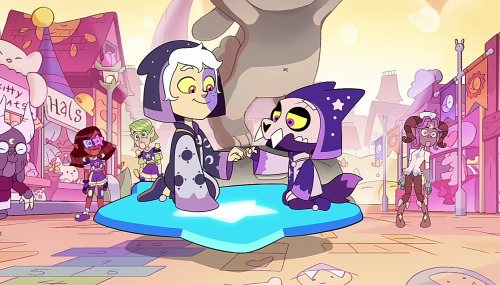Your gateway to endless inspiration
For The Future - Blog Posts
Owl House S3 Episodes Ranking(Most to Least Fav)
I loved season 3 and think the crew did an amazing job wrapping the story nicely while only have 3 episodes. I have so much respect for them. I’m asking this question out of curiosity, not to disrespect the hard work done.
My ranking:
Watching & Dreaming
This finale is one of my favorites of all time. The Collector got really good development, Luz’s sacrifice and Titan form, the animation was beautiful, and pretty much every scene brought something beautiful. The fight scenes were amazingly animated and thrilling to watch. Belos’ death was so satisfying and watching him get stomped to death was somehow pretty funny. The post-credit was super cute and I liked the way the characters said bye to the audience through the Collector. The King-ceañera was sweet because I remember hearing that S3 would’ve had an episode with Luz celebrating her quinceañera. It’s sad that the episode didn’t happen but I’m glad it was included into the finale.
Thanks to Them
Luz and Hunter carried this episode for me. I really connected with them and their struggles- mental health struggles. Seeing Camila get more spotlight was great. She’s an amazing mom! The montage of what the crew was doing in the Human realm was cute and kind of bittersweet because these scenes could’ve been made into episodes, especially with Hunter questioning his identity. I liked seeing Vee again and her new human look is adorable. Flapjack’s death always makes me tear up. He was my favorite palisman so it made his sacrifice hurt more. I’m glad Belos got his retribution for all the pain he caused.
For the Future
I enjoyed this episode. Seeing everyone (Matt, Emira and Eldric, and Boscha) was great. I was happy to see Willow get some spotlight since she was pushed back for the past few episodes. I relate to her anxiety on having to keeping things together and trying to always be reliable. Hunter developing powers was great(he has a part of Flapjack left). The Huntlow moments were adorable; they are my second favorite ship and seeing them grow closer was so cute. Seeing Luz resolve her issues was great and her palisman is adorable.
The only thing that drops this episode down my ranking is the inclusion of Kikimora. Personally, I don’t care enough for Kikimora that I would want her to come back. I would’ve been fine with her last scene being in the S2 finale. I understand that she was a secondary character to Boscha’s development, but I don’t care about Boscha that much to say that Kikimora coming back was worth it. I think it bothers me because we spent a good chunk of that episode focusing on Boscha and Kikimora that the episode felt stagnant at moments. I would’ve preferred The Collector having more screen time. This issue doesn’t make me hate the episode, but it is my least favorite S3 episode.

I finished it digitally
Not only do we get owl house season 3, it's also the day Change your mind aired?? How did I not know this sooner?
Owl house is later today, if I get spoiled Imma be so sad
Some Amity Fanart :)




Also happy 7 days early For The Future 1 year anniversary ig ¯\_(ツ)_/¯
Reference image by @mellon-soup :)

HUNTLOW NATION HOW ARE WE FEELING? 😭💚💛
~ would like to one day try these when I'm free to do so 💖

the workout channels i am currently subscribed to



♡ april han - great for shorter workouts, walking workouts, and full body workouts
♡ arianna elizabeth - yoga & pilates, faith based for my fellow Christian friends <3
♡ b-life - japanese yoga channel
♡ bailey brown - pilates
♡ BIGSIS & BigSis Workout - my personal favorite, includes all kinds of workouts!
♡ boho beautiful yoga - yoga & pilates
♡ breathe and flow - yoga
♡ callie jardine gualy - pilates, another faith based channel!
♡ celamarr - mainly strength based workouts, i love her glute workouts!
♡ charlie follows - yoga, my current favorite yoga instructor!
♡ daisy keech - shorter workouts, i love her core and glute workouts
♡ daniela suarez - stretching
♡ dansique fitness - pilates & ballet style workouts
♡ eleni fit - another fav of mine, posts all kinds of workouts like cardio, pilates, stretching, and some strength training
♡ emi wong - all types of workouts, great for shorter workouts but she does have quite a few 30-45+ minute long videos!
♡ eylem abaci - great for shorter workouts!
♡ feel good with olya - pilates
♡ fitness__kaykay - great for cardio & strength training, her workouts are INTENSE
♡ five park yoga w/ erin sampson - yoga
♡ gayatri yoga - yoga & pilates workouts, includes a lot of longer videos
♡ growingannanas - so many different routines and types of workouts! i adore her
♡ growwithjo - lots of different types and lengths of cardio workouts. i love love love her walking workouts, they will never fail to give you a boost
♡ hailey c. - mainly short workouts and stretches
♡ heather robertson - mainly strength training, but she has so many workouts and the vast majority are 30+ minutes long
♡ hong rabbit - pilates
♡ jessica richburg - yoga
♡ juice & toya - mainly strength training
♡ julia.reppel - mobility routines & stretches with some strength mixed in
♡ kaila wen - short pilates workouts
♡ lena snow - doesn’t really post anymore unfortunately but i love her longer workouts
♡ lidia mera - pilates
♡ livaligned pilates - pilates
♡ luisa giuliet - short strength training
♡ madelaine rascan - strength training
♡ madeleine abeid - pilates
♡ madfit - so many types of workouts, with and without equipment!
♡ mady morrison - yoga & stretching
♡ mary braun - shorter workouts
♡ MIZI - all different types of workouts, mainly cardio/full body
♡ move with nicole - pilates
♡ moving mango pilates - pilates
♡ nathalie shanti - pilates & some yoga
♡ nina dapper - shorter pilates style workouts
♡ nobadaddiction - so many different workouts with different lengths, i mainly do their hiit workouts
♡ olivia lawson - many metabolic/walking cardio workouts, includes many with weights!
♡ oppserve - many shorter workouts and stretches
♡ pilatesbodyraven - pilates
♡ ps fit - previously popsugar, so many different workouts!
♡ raminara - yoga & pilates
♡ rachel’s fit pilates - wall pilates
♡ sanne vloet - pilates
♡ shirlyn kim - many shorter workouts, including cardio and pilates
♡ squatcouple - mostly strength training
♡ sunfit - yoga/pilates
♡ the bare female - yoga
♡ the glow method - yoga & pilates
♡ the yoga ranger studio - yin & restorative yoga
♡ train with gainsbybrains - many <20 minute strength training, no equipment workouts
♡ travis elliot - yoga
♡ vicky justiz - shorter strength training & pilates workouts with some stretching
♡ yisoo fit - <30 min workouts & stretching
♡ yoga song - hayeon - yoga & shorter workouts
♡ yoga with adrienne - yoga
♡ yoga with bird - yoga
♡ yoga with kassandra - yoga
♡ yoga with kate amber - yoga
♡ yoga with tim - yoga
♡ bbangneu - many long, full body workouts! (a new fav)




Las hermanas Clawthorne 🧡




Visitando a Raine...




Increíble como puede cambiar tanto que pasemos de temerle a querer abrazarlo x'd




Stringbean 💜

"¿Planes para convertir el gimnasio en una sala común? ¿Horarios para turnos rotativos de guardia? ¿Eso es un menú usando vegetales del salón de plantas?"

"¡Matt Thonomule, eres realmente un líder decente!"
"¿A caso has tenido alguna duda?"

"Sí. Muchas, muchas dudas."



Los hermanos Blight reunidos 💚💜






Hunter y Raine poseídos por Belos.

Puntos extra por esa sonrisa siniestra xd



Ella solo quería ser comprendida 💜

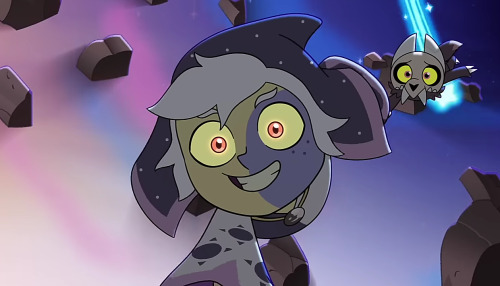
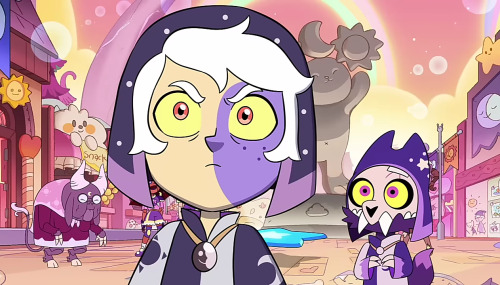


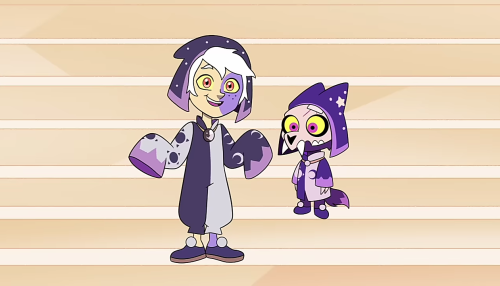
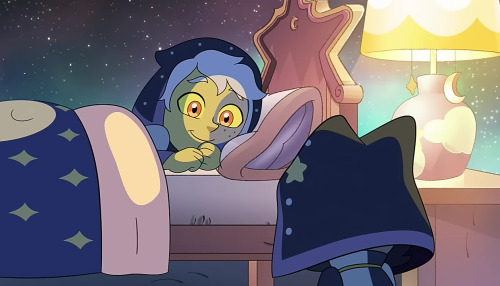
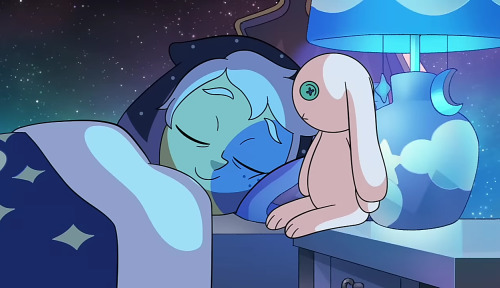


✨Apreciación al Coleccionista✨
Luzura Plush WIP






Here is the work in progress for the Luzura Plushie that will be up for pre orders when FTF releases soon! Same goes with The Collector aaand Amity!! If you are interested please do let me know, because this is a limited time thing! The only thing that is needs to be fixed is the embroidery on the hair, the stars and light orb will b a lighter brown to match her hair.




As it was becoming clear the US was headed into trade war territory, I got really interested in farming and the logistics of keeping people fed. I turned that interest into "your cool city needs a food supply," available now!
it's a hack of "i'm sorry did you say street magic" and "Microscope," two gold-standard worldbuilding games. It was polished by Nico MacDougall, who gave me some great advice on how to make this game really align with the themes and ideas I had in the draft.
I've always been a sicko about logistics and agriculture (growing up in the US midwest will do that to you), and I hope this game helps people think about how great a privilege it is to eat.
Words for Skin Tone | How to Describe Skin Color
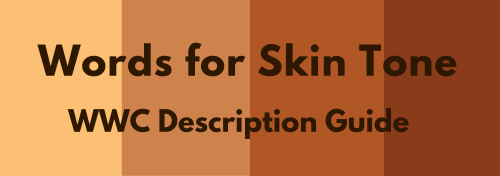
We discussed the issues describing People of Color by means of food in Part I of this guide, which brought rise to even more questions, mostly along the lines of “So, if food’s not an option, what can I use?” Well, I was just getting to that!
This final portion focuses on describing skin tone, with photo and passage examples provided throughout. I hope to cover everything from the use of straight-forward description to the more creatively-inclined, keeping in mind the questions we’ve received on this topic.
Standard Description
Basic Colors

Pictured above: Black, Brown, Beige, White, Pink.
“She had brown skin.”
This is a perfectly fine description that, while not providing the most detail, works well and will never become cliché.
Describing characters’ skin as simply brown or beige works on its own, though it’s not particularly telling just from the range in brown alone.
Complex Colors
These are more rarely used words that actually “mean” their color. Some of these have multiple meanings, so you’ll want to look into those to determine what other associations a word might have.

Pictured above: Umber, Sepia, Ochre, Russet, Terra-cotta, Gold, Tawny, Taupe, Khaki, Fawn.
Complex colors work well alone, though often pair well with a basic color in regards to narrowing down shade/tone.
For example: Golden brown, russet brown, tawny beige…
As some of these are on the “rare” side, sliding in a definition of the word within the sentence itself may help readers who are unfamiliar with the term visualize the color without seeking a dictionary.
“He was tall and slim, his skin a russet, reddish-brown.”
Comparisons to familiar colors or visuals are also helpful:
“His skin was an ochre color, much like the mellow-brown light that bathed the forest.”
Modifiers
Modifiers, often adjectives, make partial changes to a word.The following words are descriptors in reference to skin tone.
Dark - Deep - Rich - Cool
Warm - Medium - Tan
Fair - Light - Pale
Rich Black, Dark brown, Warm beige, Pale pink…
If you’re looking to get more specific than “brown,” modifiers narrow down shade further.
Keep in mind that these modifiers are not exactly colors.
As an already brown-skinned person, I get tan from a lot of sun and resultingly become a darker, deeper brown. I turn a pale, more yellow-brown in the winter.
While best used in combination with a color, I suppose words like “tan” “fair” and “light” do work alone; just note that tan is less likely to be taken for “naturally tan” and much more likely a tanned White person.
Calling someone “dark” as description on its own is offensive to some and also ambiguous. (See: Describing Skin as Dark)
Undertones
Undertones are the colors beneath the skin, seeing as skin isn’t just one even color but has more subdued tones within the dominating palette.
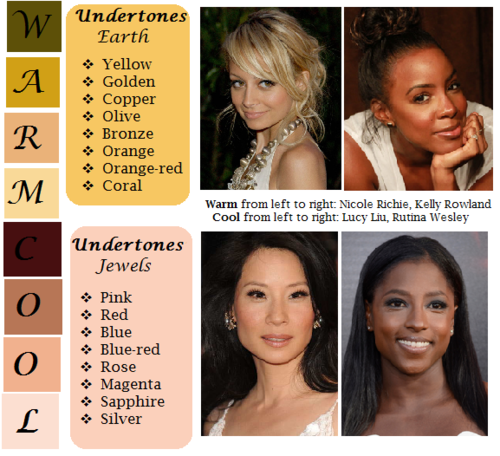
pictured above: warm / earth undertones: yellow, golden, copper, olive, bronze, orange, orange-red, coral | cool / jewel undertones: pink, red, blue, blue-red, rose, magenta, sapphire, silver.
Mentioning the undertones within a character’s skin is an even more precise way to denote skin tone.
As shown, there’s a difference between say, brown skin with warm orange-red undertones (Kelly Rowland) and brown skin with cool, jewel undertones (Rutina Wesley).
“A dazzling smile revealed the bronze glow at her cheeks.”
“He always looked as if he’d ran a mile, a constant tinge of pink under his tawny skin.”
Standard Description Passage
“Farah’s skin, always fawn, had burned and freckled under the summer’s sun. Even at the cusp of autumn, an uneven tan clung to her skin like burrs. So unlike the smooth, red-brown ochre of her mother, which the sun had richened to a blessing.”
-From my story “Where Summer Ends” featured in Strange Little Girls
Here the state of skin also gives insight on character.
Note my use of “fawn” in regards to multiple meaning and association. While fawn is a color, it’s also a small, timid deer, which describes this very traumatized character of mine perfectly.
Though I use standard descriptions of skin tone more in my writing, at the same time I’m no stranger to creative descriptions, and do enjoy the occasional artsy detail of a character.
Creative Description
Whether compared to night-cast rivers or day’s first light…I actually enjoy seeing Characters of Colors dressed in artful detail.
I’ve read loads of descriptions in my day of white characters and their “smooth rose-tinged ivory skin”, while the PoC, if there, are reduced to something from a candy bowl or a Starbucks drink, so to actually read of PoC described in lavish detail can be somewhat of a treat.
Still, be mindful when you get creative with your character descriptions. Too many frills can become purple-prose-like, so do what feels right for your writing when and where. Not every character or scene warrants a creative description, either. Especially if they’re not even a secondary character.
Using a combination of color descriptions from standard to creative is probably a better method than straight creative. But again, do what’s good for your tale.
Natural Settings - Sky

Pictured above: Harvest Moon -Twilight, Fall/Autumn Leaves, Clay, Desert/Sahara, Sunlight - Sunrise - Sunset - Afterglow - Dawn- Day- Daybreak, Field - Prairie - Wheat, Mountain/Cliff, Beach/Sand/Straw/Hay.
Now before you run off to compare your heroine’s skin to the harvest moon or a cliff side, think about the associations to your words.
When I think cliff, I think of jagged, perilous, rough. I hear sand and picture grainy, yet smooth. Calm. mellow.
So consider your character and what you see fit to compare them to.
Also consider whose perspective you’re describing them from. Someone describing a person they revere or admire may have a more pleasant, loftier description than someone who can’t stand the person.
“Her face was like the fire-gold glow of dawn, lifting my gaze, drawing me in.”
“She had a sandy complexion, smooth and tawny.”
Even creative descriptions tend to draw help from your standard words.
Flowers
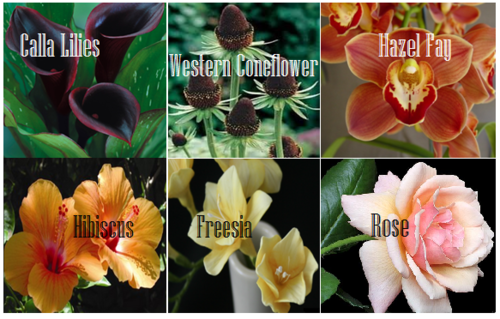
Pictured above: Calla lilies, Western Coneflower, Hazel Fay, Hibiscus, Freesia, Rose
It was a bit difficult to find flowers to my liking that didn’t have a 20 character name or wasn’t called something like “chocolate silk” so these are the finalists.
You’ll definitely want to avoid purple-prose here.
Also be aware of flowers that most might’ve never heard of. Roses are easy, as most know the look and coloring(s) of this plant. But Western coneflowers? Calla lilies? Maybe not so much.
“He entered the cottage in a huff, cheeks a blushing brown like the flowers Nana planted right under my window. Hazel Fay she called them, was it?”
Assorted Plants & Nature

Pictured above: Cattails, Seashell, Driftwood, Pinecone, Acorn, Amber
These ones are kinda odd. Perhaps because I’ve never seen these in comparison to skin tone, With the exception of amber.
At least they’re common enough that most may have an idea what you’re talking about at the mention of “pinecone."
I suggest reading out your sentences aloud to get a better feel of how it’ll sounds.
"Auburn hair swept past pointed ears, set around a face like an acorn both in shape and shade.”
I pictured some tree-dwelling being or person from a fantasy world in this example, which makes the comparison more appropriate.
I don’t suggest using a comparison just “cuz you can” but actually being thoughtful about what you’re comparing your character to and how it applies to your character and/or setting.
Wood

Pictured above: Mahogany, Walnut, Chestnut, Golden Oak, Ash
Wood can be an iffy description for skin tone. Not only due to several of them having “foody” terminology within their names, but again, associations.
Some people would prefer not to compare/be compared to wood at all, so get opinions, try it aloud, and make sure it’s appropriate to the character if you do use it.
“The old warlock’s skin was a deep shade of mahogany, his stare serious and firm as it held mine.”
Metals

Pictured above: Platinum, Copper, Brass, Gold, Bronze
Copper skin, brass-colored skin, golden skin…
I’ve even heard variations of these used before by comparison to an object of the same properties/coloring, such as penny for copper.
These also work well with modifiers.
“The dress of fine white silks popped against the deep bronze of her skin.”
Gemstones - Minerals
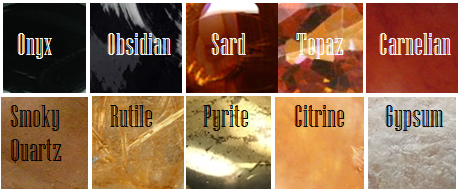
Pictured above: Onyx, Obsidian, Sard, Topaz, Carnelian, Smoky Quartz, Rutile, Pyrite, Citrine, Gypsum
These are trickier to use. As with some complex colors, the writer will have to get us to understand what most of these look like.
If you use these, or any more rare description, consider if it actually “fits” the book or scene.
Even if you’re able to get us to picture what “rutile” looks like, why are you using this description as opposed to something else? Have that answer for yourself.
“His skin reminded her of the topaz ring her father wore at his finger, a gleaming stone of brown, mellow facades.”
Physical Description
Physical character description can be more than skin tone.
Show us hair, eyes, noses, mouth, hands…body posture, body shape, skin texture… though not necessarily all of those nor at once.
Describing features also helps indicate race, especially if your character has some traits common within the race they are, such as afro hair to a Black character.
How comprehensive you decide to get is up to you. I wouldn’t overdo it and get specific to every mole and birthmark. Noting defining characteristics is good, though, like slightly spaced front teeth, curls that stay flopping in their face, hands freckled with sunspots…
General Tips
Indicate Race Early: I suggest indicators of race be made at the earliest convenience within the writing, with more hints threaded throughout here and there.
Get Creative On Your Own: Obviously, I couldn’t cover every proper color or comparison in which has been “approved” to use for your characters’ skin color, so it’s up to you to use discretion when seeking other ways and shades to describe skin tone.
Skin Color May Not Be Enough: Describing skin tone isn’t always enough to indicate someone’s ethnicity. As timeless cases with readers equating brown to “dark white” or something, more indicators of race may be needed.
Describe White characters and PoC Alike: You should describe the race and/or skin tone of your white characters just as you do your Characters of Color. If you don’t, you risk implying that White is the default human being and PoC are the “Other”).
PSA: Don’t use “Colored.” Based on some asks we’ve received using this word, I’d like to say that unless you or your character is a racist grandmama from the 1960s, do not call People of Color “colored” please.
Not Sure Where to Start? You really can’t go wrong using basic colors for your skin descriptions. It’s actually what many people prefer and works best for most writing. Personally, I tend to describe my characters using a combo of basic colors + modifiers, with mentions of undertones at times. I do like to veer into more creative descriptions on occasion.
Want some alternatives to “skin” or “skin color”? Try: Appearance, blend, blush, cast, coloring, complexion, flush, glow, hue, overtone, palette, pigmentation, rinse, shade, sheen, spectrum, tinge, tint, tone, undertone, value, wash.
Skin Tone Resources
List of Color Names
The Color Thesaurus
Skin Undertone & Color Matching
Tips and Words on Describing Skin
Photos: Undertones Described (Modifiers included)
Online Thesaurus (try colors, such as “red” & “brown”)
Don’t Call me Pastries: Creative Skin Tones w/ pics I
Writing & Description Guides
WWC Featured Description Posts
WWC Guide: Words to Describe Hair
Writing with Color: Description & Skin Color Tags
7 Offensive Mistakes Well-intentioned Writers Make
I tried to be as comprehensive as possible with this guide, but if you have a question regarding describing skin color that hasn’t been answered within part I or II of this guide, or have more questions after reading this post, feel free to ask!
~ Mod Colette
I don't know if this is the correct blog or another one of yours for this question. My question is: How do I come up with fantasy animals and plants? Like in video games for example? I can never get creative when it comes to these two things
Writing Ideas: Fantasy Animals & Plants
How to Create Fantasy Creatures/Animals
Writing Worksheet: Fictional Plants
Yup, this is the right blog, haha. Here are some tips to create fantasy creatures/animals from different sources, and a worksheet to help guide you in creating fictional plants, which you can add fantasy elements into. And below are some additional references for inspiration. Choose which ones you prefer to incorporate in your story to help create your fantasy animal/plant:
Types of Animals ⚜ List of Legendary Beasts & Monsters
Word List: Animals (1) (2) ⚜ Animal Adjectives ⚜ Birds
Flightless Birds ⚜ Fantasy Creatures ⚜ Fictional Monster
Fantasy Character Names ⚜ Medieval Beasts (1) (2)
Medieval Plants ⚜ Medicinal Herbs ⚜ Meat-Eating Plants
Poisonous Plants ⚜ Poison Ivy & Poison Oak ⚜ Roses
Shade-Loving Plants ⚜ List of Flowers ⚜ Flower Remedies
Some Ecology Vocabulary
Resources on Creature Design (Wildlife Fact Sheet)
World-Building Template (with sections on flora and fauna)
After choosing your preferred animals/plants to use as inspiration, it is advisable to research more on them for added historical/cultural context if they would be appropriate for your specific story. Hope this helps with your writing!
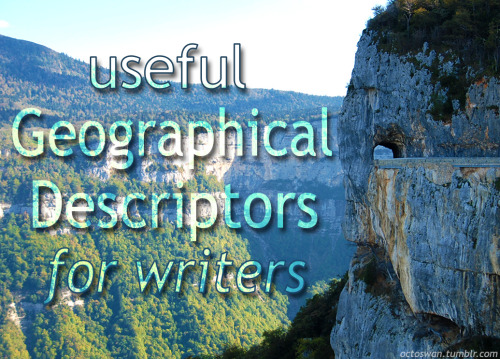


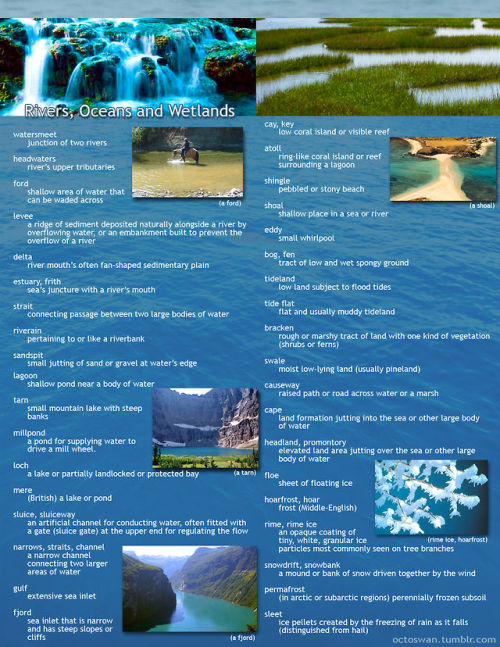
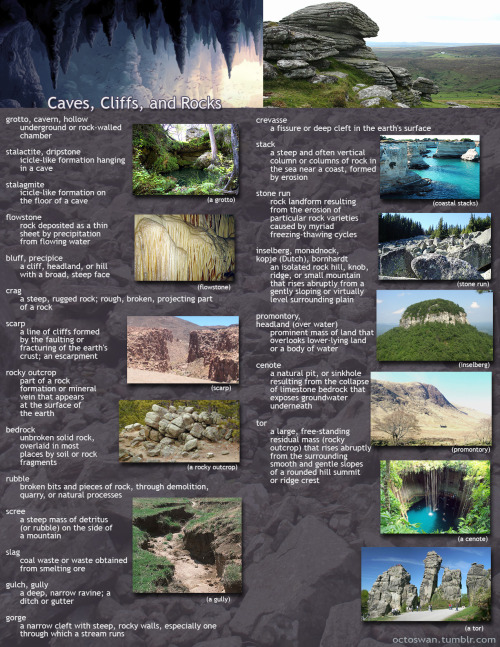
I made these as a way to compile all the geographical vocabulary that I thought was useful and interesting for writers. Some descriptors share categories, and some are simplified, but for the most part everything is in its proper place. Not all the words are as useable as others, and some might take tricky wording to pull off, but I hope these prove useful to all you writers out there!
(save the images to zoom in on the pics)
Small fantasy worldbuilding elements you might want to think about:
A currency that isn’t gold-standard/having gold be as valuable as tin
A currency that runs entirely on a perishable resource, like cocoa beans
A clock that isn’t 24-hours
More or less than four seasons/seasons other than the ones we know
Fantastical weather patterns like irregular cloud formations, iridescent rain
Multiple moons/no moon
Planetary rings
A northern lights effect, but near the equator
Roads that aren’t brown or grey/black, like San Juan’s blue bricks
Jewelry beyond precious gems and metals
Marriage signifiers other than wedding bands
The husband taking the wife's name / newlyweds inventing a new surname upon marriage
No concept of virginity or bastardry
More than 2 genders/no concept of gender
Monotheism, but not creationism
Gods that don’t look like people
Domesticated pets that aren’t re-skinned dogs and cats
Some normalized supernatural element that has nothing to do with the plot
Magical communication that isn’t Fantasy Zoom
“Books” that aren’t bound or scrolls
A nonverbal means of communicating, like sign language
A race of people who are obligate carnivores/ vegetarians/ vegans/ pescatarians (not religious, biological imperative)
I’ve done about half of these myself in one WIP or another and a little detail here or there goes a long way in reminding the audience that this isn’t Kansas anymore.
Worldbuilding and Magic Systems: Things to Consider
Have a magic system in mind for your fantasy world? Here's a list of things to consider to help you tie this system into the rest of your worldbuilding, so that it feels more believable and realistic.
Source
What is the source of magic? Is it natural or man-made? Can humans use magic or is it a force of nature that only animals or other races can use?
Does magic originate from inside a person or does it require external items to use? If it comes from items, can the items be made? How long does it take to make the items?
Does the magic cost anything- money, stamina, health, etc.?
Can a person be cut off from being able to use magic? If so, how?
Prevalence
How common is magic in your world? Is it so common that everyone has seen it or is it a subject of myths and rumors?
How long have the people in your world known about magic? Has it always been there or is it a new discovery?
How much does the average person know about magic? How much do experts know? What do people not understand about this magic? Are there any common misconceptions? Myths?
Is magic revered or feared? Or if it's common, is it taken for granted? Are there any taboos surrounding magic?
How many types of magic are there? Are some more common than others?
Are there dedicated schools of thought surrounding the study of magic? Is it taught about in schools? If so, is it taught to children or only at the college (or equivalent) level?
Accessibility
Who can use magic? Who can't? Is it something that only the rich and powerful can use? Why? Or do genetics determine who can use it? Wealth?
Are there any physical limitations that might restrict who can use magic? For instance, maybe old or sickly people can't use magic because it requires a lot of physical effort. Does your society provide accommodations for people who can't use magic? Is a lack of magic ability considered a disability?
Does education level determine capacity for magic?
How easy is it to gain access to magic? How easy is it to learn about magic?
Power/Usefulness
How powerful or useful is magic for different parts of society? Military? Medicine? Entertainment? Art? Childcare? Government? Communication? Business?
How does magic affect the politics of your world? How does it shape the economy? Are there feuds over the use of magic? Do powerful groups in your world have an incentive to limit the use and accessibility of magic? Why?
What happens when people no longer have access to magic? Does this cripple their ability to go through their daily lives? How?
Mix, match, and cross-reference these with other elements of your worldbuilding to form a believable magic system that lives and breaths just as the rest of your world does. For every answer you give to the questions above, consider and build upon the implications of what that might mean for your world. A worldbuilder's best skill is the ability to ask "How will this affect ___?" So make sure you're always considering the ripple effects of each element you add to your world.
Happy worldbuilding y'all!


























